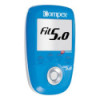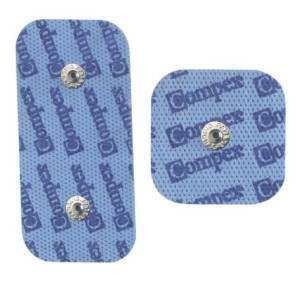Compex Fitness Wireless Fit 5 Muscle Stimulator
Ref. 63031
€541.66
prix conseillé : 649,99 €
No queries yet, leave the first!
Description
Compex Fitness Fit 5 :
Develops your muscles, sculpts your body and helps you relax.
Designed for people who workout daily, Fit 5.0 is the ultimate product in the range, as it also includes Compex wireless technology.
Delivered with 2 stimulation modules, Fit 5.0 is also modular, with the option to add 2 additional modules for even more effective performance.
Technology : Wire :
Muscle Intelligence MI-scan, MI-range on the 2 modules
Web connection Yes
Download objective No
Upload remote history Yes
Program categories * Pain management, Rehabilitation, Recovery / Massage, Fitness
Nb of programs 30
Nb of channels 2
Screen Matrix colors
Power 120 mA, 400 us, 150 Hz
Energy Rechargeable battery in less than 4h30
Accessories Soft travel pouch, 1 bag of Snap electrodes 5x10 cm, 1 bag of Snap electrodes 5x5 cm, 2 bags of Snap electrodes 5x10 cm (1 clip)
* Pain management
Pain management TENS . Reduce muscle tension . Muscle pain . Neck pain . Back pain . Lumbago . Epicondilitis . Tendinitis . Heavy legs . Cramp prevention .
Rehabilitation
Muscle atrophy . Reinforcement.
Recovery / Massage
Training recovery . Relaxing massage . Reduce muscle soreness . Reviving massage .
Fitness
Firm your arms . Tone your thighs . Get a 6-pack . Get stronger biceps . Build your shoulders . Build your pecs . Firm your stomach . Shape you buttocks . Body power . Cross-training . Muscle building . Warm-up . Capillarisation . Lymphatic drainage.
Placement of electrodes. The size of the electrodes (large or small) and the way they are placed on the group of muscles that you wish to stimulate, are crucial factors in how comfortable, and therefore how effective, the workout will be.
It is therefore recommended that you always dedicate particular care to this and that you comply with the suggested placements.
For stimulation with the Mi-sensor system, all the suggested placements represent the optimal positioning of this system. It is therefore recommended that you follow these instructions carefully.
If you do not want to use Mi- technology, all you need to do is to replace the special electrode cable of the Mi-sensor system with another standard electrode cable. Stimulation position. The stimulation position depends on the muscle group to be stimulated. The various suggested positions are clearly indicated in pictograms next to the pictures illustrating electrode placement.
For programmes that trigger significant contractions (tetanic contractions), isometric work is recommended, i.e., the extremities of the limbs should be fixed so that there is no significant movement. For example, when stimulating the quadriceps, the user should be in a seated position with the ankles fixed with straps to prevent extension of the knees.
Working in this way has a dual purpose: on the one hand, to ensure greater safety and, on the other, to limit shortening of the muscle during the contraction, with the risk of sharp cramps under stimulation. As the contraction is particularly strong at the calf when the foot is extended, make sure that you have a sufficiently large load on your shoulders (or using some other means) so that the contraction remains static.
With the exception of specific indications for a particular programme, dynamic work should not be done without resistance.
For the other types of programmes (for example, the programmes of the Vascular, Massage and Pain categories and the Active recovery programme), which do not involve powerful muscular contractions, position yourself as comfortably as possible. Setting the stimulation intensity/energy levels. In a stimulated muscle, the number of recruited fibres depends on the stimulation energy.
It is therefore absolutely necessary to use maximum stimulation energies so as to involve the greatest possible number of fibres. Below a significant stimulation energy level, it is pointless, for an average user, to do stimulation sessions. In fact, the number of fibres involved in the stimulated muscle is too low for any interesting improvement in the performance of that muscle.
The progress of a stimulated muscle will be all the greater if a high number of its fibres are recruited by the Compex. If only 1/10 of the fibres of a muscle work under stimulation, only that 1/10 can progress. That is obviously much less appreciable than if 9/10 of the fibres work and can therefore progress.
You should therefore take care to work with maximum stimulation energies, i.e., always at the limit of what you can support.
There is obviously no need for you to reach the maximum current strength right from the first contraction of the first session of the first cycle. If you have never used Compex stimulation before, you should do a few sessions of the Muscle starter programme, with sufficient energy to produce powerful muscular contractions to familiarise yourself with the technique of electrostimulation. You can then start your first stimulation cycle with your own specific programme and level. After the warm-up, which must produce very clear muscular twitches, you should raise the stimulation energy progressively, from contraction to contraction, during the first three or four minutes of the work sequence. You should also progress with stimulation energies used from session to session, particularly during the first three sessions of a cycle. A normally prepared person will already reach very significant stimulation energies during the fourth session. Scheduling of the stimulation sessions. The question of the scheduling of the stimulation sessions during the week only arises in situations where at least two training sessions are to be done in the same.
In cases where up to six sessions a week are planned, it is recommended that the sessions be scheduled as far apart as possible. For example, anyone who does three sessions a week should do them at the rate of one session every two days (one rest day twice and two rest days once every week). Anyone who does six sessions should do six consecutive days of stimulation with one rest day.
Above seven sessions a week, it is advisable to group several sessions together on the same day to leave yourself one or two complete rest days without stimulation. Anyone who does seven sessions a week should do five days of stimulation, at the rate of one session per day with one two-session day(s) (with at least a half-hour's rest between the sessions), leaving one rest day. Anyone who does ten sessions a week should preferably do five two-session days (again with at least a half-hour's rest between the sessions), leaving two rest days. Alternation of stimulation sessions/voluntary training. The stimulation sessions can be done outside or during voluntary training. When voluntary training and stimulation are done during the same session, it is generally recommended that the voluntary training be done first followed by the stimulation.
This means that the voluntary training is not done on muscle fibres which are already tired. This is particularly important for strength and explosive strength training.
However, in resistance training, it can be very useful to proceed in the reverse order. Before the voluntary training, by means of stimulation for resistance, a “specific pre-fatigue session” is carried out on the muscle fibres without general and cardio-vascular fatigue. In this way, the voluntary effort on the “prepared” fibres will push the glycolytic metabolism faster and further. Progression of the levels. In general, it is not advisable to go through the different levels quickly with the intention of reaching the highest level as fast as possible. The different levels correspond to progress in training and you must leave the muscles time to adapt, and time for the overcompensation to be put in place.
The most frequent error is to change from level to level as stimulation occurs at increasingly higher stimulation energies. The number of fibres subjected to stimulation depends on the stimulation energy. The nature and amount of work that these fibres do depend on the programme and level. The aim is, first of all, to progress through the electrical stimulation energies and then through the levels. The more numerous the muscle fibres you stimulate, the more numerous will be the fibres that are going to progress. But the speed of progress of these fibres and their aptitude for operating at a higher rating depend on the programme and level used, the number of sessions per week and the length of these sessions, and also on intrinsic factors particular to each individual.
The simplest and most usual procedure is to raise the level in the programme selected when changing to a new stimulation cycle.
It is also possible to go up a level in the course of the same cycle. In this case, it is advisable not to do so before working a minimum of three weeks at the same level.
Do not change level during an auxiliary or maintenance application. Do not change level either during a short intensive or aggressive cycle of three to four weeks. On the other hand, following the classic approach, during a six-week cycle, after three weeks you can change to the level above. Similarly, in an intensive or aggressive cycle of six to eight weeks, you can go up a level after three to four weeks. Warming-up stimulation. All the programmes involving significant contractions (tetanic contractions) of the stimulated muscles automatically start with a warming-up sequence. This is indicated on the screen by an animated rising convection symbol above the heater symbol.
If no voluntary physical activity has been done in the minutes preceding the stimulation session, it is recommended that you do the warm-up. If the stimulation session is included in a voluntary training session and some voluntary activity immediately precedes the stimulation, it is unnecessary to do the warming-up sequence. You can therefore delete the rising convection symbol, and the session will start directly with the specific work selected without any prior warm-up.
After the stimulation work sequence, a relaxation sequence starts automatically. This is to allow improvement in the recovery of a muscle after its work under Compex and to limit muscular aches to some extent. Unless you want to go on immediately to voluntary training stages, it is recommended that you let the last sequence go ahead. It is also recommended, even if the stimulation seems to improve your muscular elasticity, that you do some stretching of the muscles that you have just worked with the Compex.
Features
- Brand Compex
- Reference 63031
- EAN13 7640109600263
- Manufacturer reference 2537116
Internet users also chose
Our experts answer you
Be the first to ask a question about this product!













Customer reviews
No customer reviews for the moment.
Your review appreciation cannot be sent
Report comment
Report sent
Your report cannot be sent